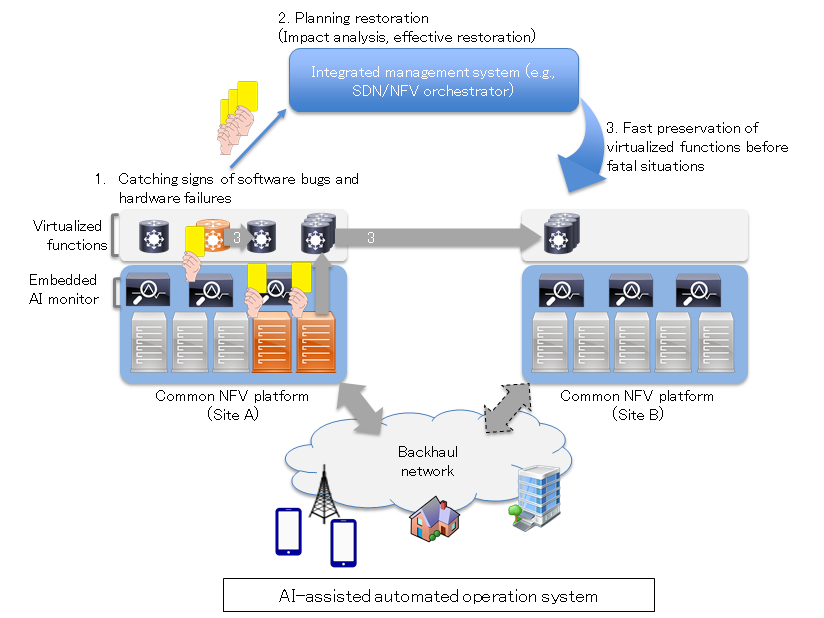 Print
Print
World’s first successful AI-assisted automated network operation system PoC towards 5G
-Exhibited in Mobile World Congress 2016-
February 22, 2016
KDDI R&D Laboratories, Inc.
KDDI R&D Laboratories Inc., in cooperation with Wind River KK, Hewlett-Packard Japan, Ltd., Brocade Communications Systems K.K., developed an artificial intelligence (AI)*1 -assisted automated network operation system for the network virtualization era and succeeded in delivering the world’s first proof-of-concept (PoC) for automated network operation based on failure prediction by AI.
In the PoC, an AI-based monitoring system made possible advance detection of fatal situations caused by, for example, software bugs with greater than 90% precision, and then service was preserved by using a migration technique that was approx. 5 times faster than the conventional technique.
Highlights from the PoC will be showcased at the Mobile World Congress (MWC) 2016 in Barcelona, Spain, at the Intel booth, Hall 3, booth # 3D30.

Moving towards high quality 5G network, KDDI R&D Labs contribute to network virtualization technologies*3 to achieve both streamlining complexed operation and network flexibility for serving such applications as IoT/M2M.*2 Technologies around NFV*4 / SDN*5 network operation systems will contribute to the standardization bodies such as TMForum*6 and ETSI*7, and those of common NFV platforms and the utilization of AI will contribute to the open source bodies such as OPNFV*8 and OpenStack*9.
Appendix
Background
Conventionally, telecom equipment consists of dedicated hardware and software to build specific elements such as a router and switch. Recently, the performance of commodity servers advanced sufficiently to run telecom equipment as virtualized functions via software, and the accompanying virtualization technologies are improving operational flexibility. In particular, the network virtualization technologies of SDN and NFV can protect important services against congestion by promptly assigning additional resources. Looking towards 5G, network virtualization must play a key role in order to flexibly meet the requirements of the emerging network applications IoT/M2M, healthcare, etc.
However, network virtualization is undergoing a developmental stage, especially from a complex failure-recovery operation aspect. To address this issue, KDDI R&D labs successfully created a PoC for automated failure-recovery with an interworked SDN/NFV orchestrator5 and operation support systems, in May of last year. Based on this achievement, KDDI R&D labs is leading standardization activities in TMForum and ETSI to accelerate the relevant discussions.
On the other hand, the penetration of commodity servers and open source software into telecom infrastructures may increase failure cases caused by hardware degradation and software bugs, which are hard to detect or predict by network monitoring or diagnosis. These cases may cause serious damage to services by falling into blind spots during automated operation. Technologies that can predict the rare events and combat them are not currently established enough; and standards and implementations either, accordingly.
About this PoC
A) Overview
To predict serious potential failures, an AI-based monitoring system is embedded in the common NFV platform. An AI-based monitor effectively learns and determines the conditions, and then the SDN/NFV orchestrator provides an appropriate recovery plan so that potentially-affected services are quickly preserved in advance of a fatal situation. The success of this PoC is the world’s first achievement as an important step toward the network virtualization era supporting 5G.
B) Outcomes
This outcome helps preserve services against the rare events described above as well as the predefined failures detected as regular equipment alarms. An overview and technical points of the PoC are as follows;
- Distributed AI monitors embedded in the common NFV platform learn and predict anomalies caused by hardware and software. Next, the anomaly trend is detected by the AI monitor if it is thought to cause fatal situations. A distributed approach of AI monitor is taken because of the need for precise analyses and learning from the huge volume of statistical data.
- The anomaly trends detected by the AI monitor are gathered into the integrated management system, and then the SDN/NFV orchestrator provides an appropriate recovery plan. For instance, software bugs (e.g., memory leak) may lead to the sudden stop of a function, and thus an alternative function is assigned. Hardware failures (e.g., anomaly of temperature caused by degradation of cooling fans) may impact multiple servers, and thus potentially-affected functions are migrated to another data center.
- Especially in the case of a hardware or facility failure affecting a substantial number of functions, fast migration techniques are applied to promptly move the virtual machines to other data centers for instance.
C) Roles of participants
The following table shows the roles of participants in this PoC.
KDDI R&D labs:
AI-assisted monitoring technology, SDN/NFV orchestrator, Virtualized function
Wind River:
Carrier grade NFV infrastructure software platform, Fast migration technique
Hewlett-Packard Japan:
Virtualized function
Brocade communications systems:
Virtualized function (Brocade vRouter product)
[Terms and brief explanation]
1 AI
Computer or machine-assisted decision, learning, presumption of conditions in order to derive answers for a specific purpose.
2 IoT/M2M
An acronym for the Internet of Things/Machine to Machine. Connecting sensors and vehicles, for example, through the network to monitor and control the systems remotely.
3 Virtualization technology
A technology to isolate, assign, and combine the computing resources of servers and storage based on specific requirements. The technology extended to network resources is referred to as network virtualization technology.
4 NFV
An acronym for Network Function Virtualization. A network virtualization technology especially applied to network function, such as router, firewall, etc.
5 SDN
An acronym for Software Defined Network and means the software-based centralized control of network resources to flexibly assign and configure the network.
6 TMForum
A global standardization body discussing the frameworks and interfaces related to network management and network businesses.
7 ETSI
An acronym for the European Telecommunications Standards Institute. A global standardization body related to broad ICT issues.
8 OPNFV
An acronym for Open Platform for NFV. An open source body and software for achieving a carrier grade NFV platform by collaborating with other open source bodies.
9 OpenStack
An open source body and software widely used to manage and control server and cloud environments.
10 SDN/NFV orchestrator
A management system controlling and assigning network function, computing resources, etc. in order to meet requirements
※The information contained in the articles is current at the time of publication.Products, service fees, service content and specifications, contact information, and other details are subject to change without notice.